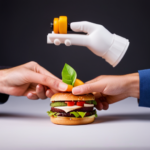Embark on a culinary journey where technology and innovation converge to reimagine the very essence of food production. ‘Exploring Global Opportunities in Food 3D Printing’ delves into the dynamic landscape of 3D printing in the realm of gastronomy, offering a visionary perspective on its transformative potential.
This article navigates the evolution, applications, global impact, and business opportunities, shedding light on the profound implications of this burgeoning trend.
Join us as we unravel the intricacies of this gastronomic revolution.
The Evolution of Food 3D Printing
The evolution of food 3D printing has revolutionized the culinary industry, shaping new possibilities for food production and customization. Technology advancements have played a pivotal role in this evolution, enabling the creation of intricate and complex designs that were once unimaginable.
Initially, 3D food printing was limited to creating simple shapes and designs using edible materials. However, with the advent of more sophisticated printing techniques and the development of edible ingredients specifically designed for 3D printing, the technology has advanced significantly. Today, food 3D printing has the capability to produce intricate confections, customized chocolates, and even intricate sugar sculptures.
Furthermore, the evolution of food 3D printing has also paved the way for personalization in the culinary world. Chefs and food enthusiasts can now experiment with flavors, textures, and presentations like never before. This level of customization not only enhances the dining experience but also opens doors to new business opportunities in the food industry.
As technology continues to advance, it is expected that food 3D printing will further evolve, potentially becoming a common feature in home kitchens and commercial food establishments.
Applications in Culinary Innovation
Exploring the applications in culinary innovation enabled by the evolution of food 3D printing reveals the potential for unprecedented creativity and customization in the culinary arts. Culinary creativity is being reimagined as chefs and food technologists experiment with intricate designs and structures that were previously unattainable through traditional cooking methods.
Food 3D printing allows for the precise layering of ingredients, opening up new possibilities for creating visually stunning dishes that not only taste exceptional but also have a unique aesthetic appeal. The technology also facilitates flavor customization, enabling chefs to tailor dishes to individual preferences and dietary requirements with an unparalleled level of precision.
This level of personalization has the potential to revolutionize the dining experience, offering a new realm of culinary exploration and enjoyment for consumers.
As the culinary world continues to embrace food 3D printing, the impact on global food accessibility is becoming increasingly significant.
Global Impact on Food Accessibility
Enabled by the evolution of food 3D printing, the applications in culinary innovation have not only fostered unprecedented creativity and customization but also have the potential to significantly impact global food accessibility. This technology holds promise in addressing food security challenges and revolutionizing the global food supply chain.
-
Enhanced Food Security:
Food 3D printing can potentially contribute to addressing food security concerns by enabling the creation of nutritious and customized food options, especially in regions with limited access to diverse food sources. -
Supply Chain Optimization:
The technology has the potential to optimize the food supply chain by reducing waste and transportation costs. It can enable the on-demand production of food items, minimizing the need for extensive storage and long-distance transportation. -
Customized Nutritional Solutions:
Food 3D printing can cater to specific dietary requirements and nutritional needs, providing personalized food options for individuals with unique dietary restrictions or health conditions.
As food 3D printing continues to advance, it presents a promising avenue for improving global food accessibility, addressing food security concerns, and transforming the traditional food supply chain.
Sustainability and Environmental Considerations
With an increasing focus on sustainability and environmental impact, food 3D printing offers a potential solution to address these concerns in the global food industry. By utilizing sustainable materials and recycling solutions, 3D printing technology can significantly reduce waste and energy consumption compared to traditional food production methods. The table below provides an overview of sustainable materials commonly used in food 3D printing and their environmental benefits.
| Sustainable Material | Environmental Benefits |
|---|---|
| Plant-based plastics | Biodegradable, reduces reliance on fossil fuels |
| Insect-based proteins | Lower environmental impact compared to traditional meats |
| Algae-based ingredients | Rapid growth, minimal land and water usage |
| Recycled food waste | Reduces landfill waste, promotes circular economy |
Incorporating these sustainable materials into food 3D printing not only aligns with the growing consumer demand for eco-friendly products but also contributes to the overall reduction of the environmental footprint of the food industry. As the technology continues to advance, the development of innovative recycling solutions for food 3D printing waste further strengthens its position as a sustainable and environmentally conscious approach to food production.
Business Opportunities and Future Trends
Utilizing sustainable materials and innovative recycling solutions for food 3D printing waste presents significant business opportunities and future trends in the global food industry. As the food 3D printing market continues to expand, there are several key areas of business opportunities and future trends to consider:
-
Development of Sustainable Materials: Investing in the research and development of sustainable materials for food 3D printing can lead to a competitive edge in the future market. Companies focusing on biodegradable and eco-friendly materials are likely to attract environmentally conscious consumers, thus presenting a strong investment potential.
-
Waste Management and Recycling Solutions: Businesses that offer efficient waste management and recycling solutions for food 3D printing waste can capitalize on the growing demand for sustainable practices within the food industry. Developing innovative methods to recycle and reuse printing waste materials can significantly reduce costs and environmental impact, thus positioning companies at the forefront of future trends.
-
Customization and Personalization: The future market for food 3D printing is expected to incline towards customization and personalization. Investing in technologies that allow for personalized nutrition and tailored food products can open up new opportunities for businesses to cater to evolving consumer preferences and dietary needs, thus presenting a promising investment potential.
These trends reflect a growing consumer demand for sustainable practices and personalized experiences, indicating substantial business opportunities and investment potential in the food 3D printing industry.
Frequently Asked Questions
How Does 3D Printing Affect the Taste and Nutritional Value of Food?
3D printing can impact taste perception and nutritional value through precise ingredient selection and customization. The technology allows for intricate designs and layering, potentially enhancing flavors and textures in food while also optimizing nutritional content.
What Are the Potential Health and Safety Concerns Associated With Consuming 3D Printed Food?
Health concerns and safety risks associated with consuming 3D printed food include potential contamination from printing materials, hygiene during production, and the long-term impact of consuming printed ingredients. Vigilant regulation and transparent labeling are crucial for consumer protection.
Are There Any Cultural or Ethical Considerations When It Comes to 3D Printing Food on a Global Scale?
Cultural considerations and ethical implications are paramount in the global scale of 3D printing food. Understanding diverse dietary habits, religious restrictions, and environmental impact is crucial. Ethical concerns encompass labor practices, food waste, and equitable access to technology.
How Do 3D Printing Technologies Impact Traditional Food Production and Farming Practices?
3D printing technologies are reshaping traditional food production and farming practices. The impact on sustainability is significant, leading to reduced waste and energy consumption. Agricultural implications include potential disruptions to supply chains and the need for new skill sets.
What Are the Limitations and Challenges of Scaling up 3D Printed Food Production for Mass Consumption?
Scaling up 3D printed food production for mass consumption presents challenges in taste, texture, and nutritional value replication. Additionally, regulatory and safety concerns, production costs, and consumer acceptance hinder the scalability of 3D food printing.
Conclusion
In conclusion, food 3D printing is a rapidly evolving technology with the potential to revolutionize the way we produce and consume food.
According to a recent report by Allied Market Research, the global food 3D printing market is projected to reach $525.6 million by 2026, with a compound annual growth rate of 46.1%.
This indicates a significant opportunity for businesses and entrepreneurs to capitalize on this emerging trend and drive innovation in the food industry.


